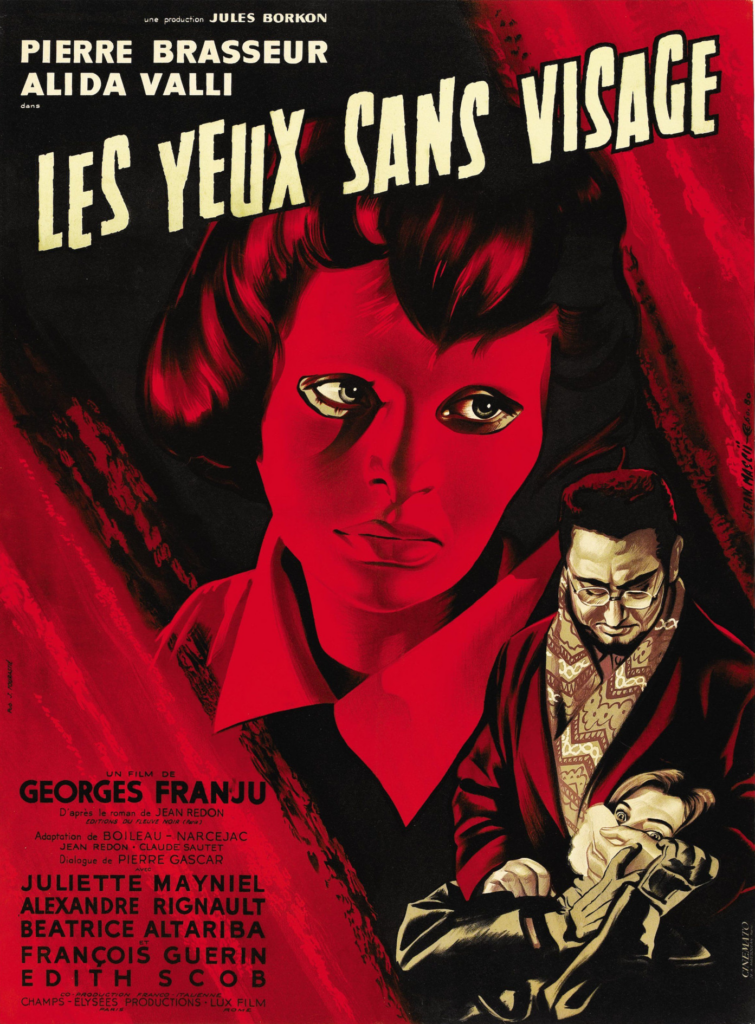

EYES WITHOUT A FACE (YEUX SANS VISAGE, LES)
(director: George Franju; screenwriter: from a book by Jean Redon/Jean Redon/Pierre Boileau/Thomas Narcejac/Claude Sautet; cinematographer: Eugen Schufftan; editor: Gilbert Natot; music: Maurice Jarre; cast: Pierre Brasseur (Prof. Genessier), Edith Scob (Christiane Genessier), Alida Valli (Louise), Francois Guerin (Jacques Vernon), Juliette Mayniel (Edna Gruber), Beatrice Altariba (Paulette), Alexandre Rignault (Inspector Parot), René Génin (Emile Tessot), Juliette Mayniel (Edna), Claude Brasseur (Inspector); Runtime: 98; Lux; 1960-France-in French with English subtitles)
“This marvelously bizarre film was a chilling mixture of art and schlock.”
Reviewed by Dennis Schwartz
One of the great lyrical classic horror stories. A noted Parisian plastic surgeon, Professor Genessier (Pierre Brasseur), is anguished that his fast driving caused a car accident resulting in his beautiful young daughter Christiane (Edith Scob) having her face completely disfigured. It’s his twisted belief that he can restore her beauty, despite modern medicine having no such curative procedures. Genessier has his assistant/nurse/lover/secretary Louise (Alida Valli), who is completely devoted to him since he used the heterografting technique to restore her own disfigured face, kidnap similar looking women to his daughter and he then forces them in his country estate lab, just outside of Paris, to have their faces removed to transplant onto his daughter. The horror in the film is the shock of watching the surgical procedures in their entirety being performed and the respected doctor act perplexed in his isolated estate about his evil deeds. Genessier also keeps a kennel full of stray dogs for torturous experimental purposes. All his grafting experiments have failed, but the arrogant doctor who is obsessed with this mad mission will not stop trying even as the bodies of the young victims start piling up.
The nocturnal story filmed in illustrious black-and-white is fantastically absurd but is hauntingly directed and acted and photographed, bringing out a sense of poetical dread. It’s as elegant as a fairy tale that defies logic, while its nuanced performances lift this horror film out of the run-of-the-mill slasher ones. It was originally titled The Horror Chamber of Dr. Faustus and is based on the work of Jean Redon, and is clearly influenced by the surrealism of the poet and filmmaker Jean Cocteau.
The film opens as Louise drives to an isolated spot and drops into the river the body of a faceless woman, whom we later learn is Emile Tessot. She probably committed suicide rather than be faced with living without a face. The professor falsely identifies her as his missing daughter at the police station to Inspector Parot and buries her as his daughter.
In his mansion, Genessier’s daughter Christiane, who wears a waxen mask to cover her hideous face, pines away for her lover, Dr. Jacques Vernon, who is her father’s innocent assistant at the hospital. Christiane so much wants him but is fearful of rejection because of her condition. Christiane phones him repeatedly just to hear his voice as he answers the phone, until there is this one time that she can’t resist saying something to him. This arouses his suspicion and he goes to Inspector Parot to report this. The inspector sets a trap by having a woman (Beatrice Altariba) recently picked-up on a shop-lifting charge pose as a patient in his hospital. The only trouble with the inspector’s plan is that he didn’t believe fully in it and when the doctor releases his patient in the middle of the night, there is no one to follow her. She is given a ride by Louise, as the police unethically never told her the real danger she was placing herself in– only that for this small favor to them they will have her charges dropped.
Warning: spoilers to follow in the next two paragraphs.
A most disturbing and memorable scene takes place, with the doctor called back to the hospital to talk to the police while he has just finished dislodging Altariba’s face but had not completed the procedure. She’s left with numerous scissors attached to her surgical gown while strapped to the bed. When Christiane can’t take looking at her suffering any longer she frees her by cutting the straps; and, when the victim looks up and sees herself in the mirror, she shrieks from horror.
The only shot that matches that one is in the final sequence, when Christiane unleashed the many barking dogs on her mad father and she removes her mask to walk insanely in the nighttime woods facing only the dogs and with a dove on her shoulder, as there’s a sense of poetic justice about the way the dogs got their revenge on their tormentor and a sense of liberation her madness gives her to be free of an overbearing father.
This marvelously bizarre film was a chilling mixture of art and schlock; it successfully created an unnerving poetical ambiance. Director George Franju’s odd masterpiece could very well be the best horror movie ever made.
REVIEWED ON 11/12/2001 GRADE: A +